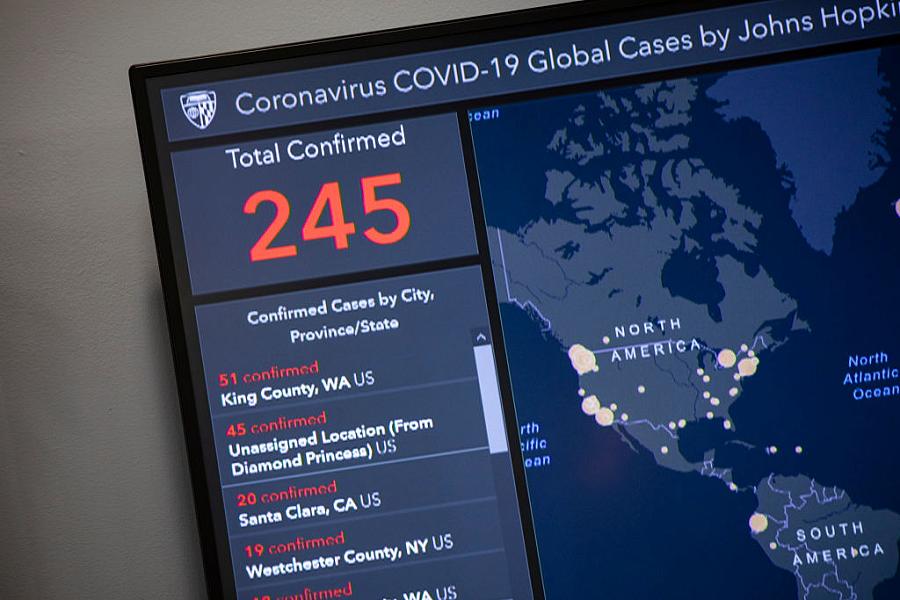Lack of data on health disparities during pandemic spurs new collaboration

Outbreak map dashboard being used by officials to track the virus. (Photo by Samuel Corum/Getty Images)
As COVID-19 ravaged the country last year, it soon became clear the disease was having a disproportionate impact on the most disadvantaged communities. Early data and reporting revealed that people of color, indigenous communities, and other groups experienced much higher case rates and deaths.
But while it was clear that the pandemic was not impacting communities equally across the country, the federal government was sharply criticized for failing to collect and report racial and ethnic data on coronavirus data in the early months of the outbreak, a lapse repeated at the state and local level in many parts of the country. Roughly 38.1% of cases reported by the federal government failed to race and ethnicity.
There were clearly huge holes in the data. To help remedy that issue and the bigger problem of missing data on health disparities, the Satcher Health Leadership Institute (SHLI) at Morehouse School of Medicine recently partnered with Google.org, the CDC Foundation, the Annie E. Casey Foundation and others to launch its Health Equity Tracker. The initial goal is to compile up-to-date demographic data on the communities hardest hit by the pandemic, but the broader goal is to form a data portal that highlights ongoing health disparities in the United States.
The tool lets users track COVID-19 cases and deaths across race and ethnicity groups, down to the county level. The tracker also incorporates data on diabetes, poverty, COPD and the number of uninsured individuals, and can compare these numbers at the national, state, and county level. For instance, the tracker reveals that many of the counties in California with the highest rates of uninsured individuals also have the highest rates of COVID-19 cases. It offers journalists an easy-to-navigate way to add context on the overlapping forces driving health disparities in their coverage area.
Last summer, public policy manager Nelson Dunlap and his team at SHLI set out to build a public facing data platform that would help track health equity across the country. “There’s a number of trackers out there that track COVID-19 specifically, but we wanted to be able to put this data into the context of health equity, to help people really understand what the disparity and inequity look like in their county and state,” Dunlap said.
Most doctors, researchers, reporters, and politicians knew about the underlying social and political forces leading to COVID-19’s devastation in communities of color. “For too long, it’s been effectively: no data, no problem for policymakers to address,” Dunlap said. “So, we figured if we can get some data, then you can’t avoid the problem any longer.”
The Health Equity Tracker initially drew its data from source The Atlantic’s COVID-19 Tracking Project, which became a vital resource for state-reported data until the CDC released county-level COVID-19 case data to select groups in late 2020. The tracker also draws on American Community Survey for data on health insurance and poverty.
After combing those existing data sources, the team still struggled to remedy data gaps stemming from racial and ethnic underreporting, misreporting, and lack of reporting in state data. Some states are making progress in this area, however. “States that were struggling in the fall with data are doing better now, and I think that’s a result of public pressure forcing leadership to step up,” Dunlap said.
The portal is deliberately aiming at a broad audience, Dunlap said. “ … What we develop has to be usable by data sciences down the hallway, but also my grandma in rural Kentucky,” he said. “She has to be able to get in there and understand what’s happening in her community so she can speak truth to power and try to help the lives of her neighbors just like the data scientists who are going to delve into the data and write white papers need to be able to use it.”
Going forward, the team is working on a legal epidemiologic dataset to explore how law and policies can create health inequities across communities. They also hope to be able to incorporate racial and ethnic data on long COVID into their data set, to provide a clearer look at how the pandemic’s lingering effects continue to burden certain communities.
“When you can look at health disparities on a map, it helps you to understand that these communities are an entire neighborhood, an entire city, an entire racial or ethnic demographic that’s dealing with this,” Dunlap said. “When you start to pick up on those trends you understand that these issues can’t just be from individual decisions — there has to be something happening

